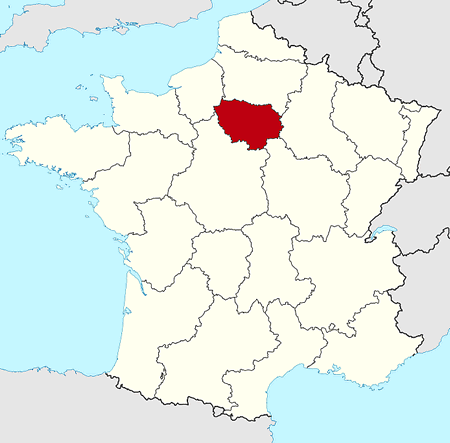 |
| location of Île-de-France |
The history of the Île-de-France, the true heart of Paris, began in the third century b.c.e. when a group of Gallic Celts built a settlement there for safety. They surrounded their settlement with a wooden palisade, at least one gate, and watchtowers. Buildings were made of wood, or wattle, mud, and sticks, and had either wooden or thatched roofs; thus fire was a constant danger. In 52 b.c.e. in his wars against the Gauls, Julius Caesar established a base there.
By the third century c.e. barbarian tribes forced the abandonment of the settlement on the Left Bank of the Seine, forcing people to seek refuge on the Île-de-France as their ancestors had nearly six centuries earlier. In 451 during the decline of the Western Roman Empire, the Île-de-France and the growing city of Paris faced its worst threat. In that year Attila the Hun attacked the Western Roman Empire with a huge army.
The city of Metz was sacked as he entered France, and Paris, according to legend, was only spared the same fate by the intervention of Saint Genevieve. By the time Attila laid siege to Orléans, the main Roman field army led by Aetius confronted him with Visigoth allies, enemies of the Huns. During the Battle at Châlons the Huns were turned back.
 |
In 476 the last Roman emperor of the West, Romulus Augustulus, was deposed, and Paris was left to look after its own defenses. The Frankish tribe was one of the German tribes to invade France during the Roman Empire’s decline, and in 508 Clovis, king of the Salian Franks, captured Paris.
He converted the Franks to Christianity after winning a battle over a rival tribe, the Alamanni, sometime between 495 and 506. Paris suffered an era of decline when Charlemagne decided to make Aachen, Aix-la-Chapelle, the capital of his Holy Roman Empire, when he was crowned emperor in 800.
In the ninth century Vikings from Scandinavia began their onslaught on western Europe, and they sailed up the Seine to imperil Paris. In 911 in order to relieve the threat, King Charles III granted the land around Rouen to the Viking leader Rollo.
Since “northmen,” normand in French, was another term for Vikings, this was the beginning of Normandy, from which Duke William would sail to conquer England in 1066. In 978 Hugh Capet became king—because he usually wore a cape, or capa, his line became known as the Capetian dynasty.
One of the greatest of all Parisian landmarks, the Cathedral of Notre Dame, was established in 1163. King Philip II Augustus, who reigned from 1179 to 1223, did much to develop the Île-de-France and Paris. He built walls around the growing city, including the settlements on the north and the south bank. By a royal charter for the University of Paris (1200), he stated that Paris was now a city of three parts, the Left Bank, the Île de Paris (now known as the Île de la Cité), and the Right Bank.
In 1200 Philip began construction of a fortress on the Seine, built to defend against the English, that would later become the famed museum of the Louvre. In 1301 King Philip IV built a royal palace on the Île de la Cité, reaffirming its position as the heart of Paris, although by this time the history of the Île de la Cité had merged into the history of the entire city of Paris.